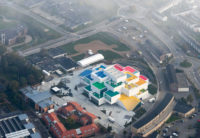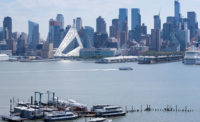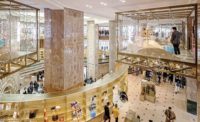For much of the industrial age, factory roofs with sawtooth clerestories brought steady north daylight into spaces where workers toiled at assembly lines and production tables. For today’s office workers, the Bjarke Ingels Group (BIG) flipped this model on its side, wrapping the facades of the Shenzhen International Energy Mansion with a zigzagging curtain wall made of alternating panels of glass and powder-coated (PVDF) aluminum. Like its industrial predecessor, the 21st-century wall system blocks a great deal of direct sunlight, reducing solar loads by 30 percent, according to the architects. BIG then took the concept one step further, pulling on the vertical folds in certain places, so they form supple curves that animate the elevations in surprising ways.
Additional Content:
Jump to credits & specifications
Located in Shenzhen’s central business district, not far from the Futian border crossing with Hong Kong, the 1 million-square-foot complex contains a pair of office towers and a nine-story connecting block with shared facilities such as a cafeteria, conference spaces, and retail. The top 13 floors of the 42-story north tower serve as the headquarters for the Shenzhen Energy Company; the rest of that building and all of the 19-story south tower will be leased to other tenants. While the Energy Mansion is surrounded by much taller buildings, including KPF’s 115-story Ping An International Finance Center, completed in 2017, it uses its curvaceous lines to stand out in the crowd.
BIG won the project in an invited competition in 2009 just as it was designing the Danish Pavilion at the 2010 World Expo in Shanghai. The theme for that Expo was “Better City, Better Life,” and the firm explored notions of “hedonistic sustainability” for its pavilion, says Bjarke Ingels, the firm’s founding partner. Many of those ideas, such as making green design beautiful and visually pleasurable, informed his work on the Energy Mansion too, as he tried to adapt modern architecture to the subtropical climate of Shenzhen. Updating the wisdom of vernacular design and collaborating with the firm Transsolar on sustainability issues, Ingels wondered if he and his team could develop “engineering without engines.” So they developed passive solar strategies such as using one tower to shade the other and designing a skin that would reduce solar loads and glare without expensive mechanical equipment. “As architects used to do, we put the performance of the building in its bones, not the machines added to it,” explains Ingels.
They ended up designing a curtain wall with tall, double-glazed panes of low-E tempered glass angled at 45 degrees in plan, so the clear portions face northwest on the west side of the building and northeast on the east side—always blocking out the stronger southeast and southwest sun with the rippled aluminum panels. Originally, the architects hoped to use solar-thermal panels that would power air-conditioning and dehumidification, but that proved too expensive.
After they established their design, the architects learned that Eero Saarinen had used a similar sawtooth curtain wall for his Laird Bell Law Quadrangle at the University of Chicago in 1959, a discovery that pleased them, says Ingels: “I’ve always admired Saarinen.” More recently, SOM designed a zigzagging glass envelope for its United States Courthouse in downtown Los Angeles.
The other ingenious aspect of the Energy Mansion is the way its folded facades get twisted into pleats at critical places—such as pedestrian entries at the northeast and southwest corners—and pulled out into a bulging slit on the upper portion of the west facade of the taller tower. These moves result in a graceful dynamism that becomes more apparent the closer you get. “We were inspired by the way Issey Miyake uses pleats in his clothes,” says Ingels.
Visitors arriving by car enter the steel-frame building at the low connecting block between the two towers, where a three-story lobby features white marble floors and walls clad in anodized aluminum and black stainless steel. Bamboo veneer on the angled fins of the building’s sawtooth perimeter and a cascading sheet of water on one wall add touches of nature to the interior. On the energy company’s office floors, low cubicles occupy the areas in the middle, while casual tables and chairs fill in the spaces along the curtain wall. The company is still trying to figure out how to use the extra space on floors where the building bulges out. Currently these areas are furnished sparsely with random chairs, while adjacent meeting rooms face them to take advantage of daylight coming in from the vertical slit.
Due to a strict zoning envelope and a tight budget, “we focused our efforts on what we had the most control over—the facades,” says Ingels. These elevations, with their pleated wrapping, perform double duty—giving the project its distinctive identity and showing how sustainability can be sexy.
CreditsArchitect: BIG-Bjarke Ingels Group
Personnel in architect's firm who should receive special credit: Partners in Charge: Bjarke Ingels, Andreas Klok Pedersen Project Manager: Martin Voelkle Project Leaders: Andre Schmidt, Song He Team: Alessio Zenaro, Alina Tamosiunaite, Alysen Hiller, Ana Merino, Andreas Geisler Johansen, Annette Jensen, Armor Rivas, Balaj IIulian, Brian Yang, Baptiste Blot, Buster Christiansen, Cecilia Ho, Christian Alvarez, Christin Svensson, Claudia Hertrich, Claudio Moretti, Cory Mattheis, Dave Brown, Dennis Rasmussen, Doug Stechschulte, Eskild Nordbud, Felicia Guldberg, Fred Zhou, Gaetan Brunet, Gül Ertekin, Henrik Kania, James Schrader, Jan Magasanik, Jan Borgstrøm, Jeppe Ecklon, Jelena Vucic, João Albuquerque, Jonas Mønster, Karsten Hansen, Malte Kloe, Mikkel Marcker Stubgaard, Michael Andersen, Michal Kristof, Min Ter Lim, Oana Simionescu, Nicklas A. Rasch, Philip Sima, Rasmus Pedersen, Rune Hansen, Rui Huang, Sofia Gaspar, Stanley Lung, Sun Ming Lee, Takuya Hosokai, Todd Bennett, Xi Chen, Xing Xiong, Xiao Lu, Xu Li, Yijie Dan, Zoltan Kalaszi Project Leader, Concept: Cat Huang Team, Concept: Alex Cozma, Kuba Snopek, Fan Zhang, Flavien Menu
Associate architect(s): SADI Shenzhen Architecture and Design Institute (local architect)
Interior designer: BIG, SADI
Engineers: ARUP
Consultants: Façade consultant until DD: FRONT
Façade consultant after DD: Aurecon
Façade contractor: Fangda Group
Contractor: CSCEC
Landscape architects: SED
Lighting consultant (competition): LICHTWERKE
Partner: Stefan Hoffmann
Lighting consultant: Kaiming Lighting
Transsolar: Sustainability
Photographer: Chaos Zhang, Laurian Ghinitoiu |
SpecificationsStructural System: Steel frame
Exterior Cladding Metal panels: PVDF coated rippled aluminum panel, Xingfa Aluminum. Metal/glass curtain wall: unitized curtain wall system at towers, stick build curtain wall system at podium Other cladding unique to this project: Vertical Aluminum Louver system in front of MEP
Roofing Other: Roof Garden
Windows Automatic Operable windows: Aumüller
Glazing Glass: Double glazing Low-E tempered glass DGU, SYP Glass
Doors Entrances: Dorma Sliding doors: Dorma
Interior Finishes Acoustical ceilings: Perforated aluminum panel system, Armstrong Ceiling & Wall Solutions Wall coverings: Bamboo panels, Shanghai Simon Curtain & Ceiling Panel Co., Ltd Resilient flooring: White Marble in lobbies, carpet in offices, bamboo flooring in key meeting rooms and vip rooms. Carpet: Haima Carpet Special interior finishes unique to this project: Black stainless steel wall cladding for all cores, Shanghai Simon Curtain & Ceiling Panel Co., Ltd
Lighting Exterior: wall wash lighting
Conveyance Elevators/escalators: Kone,
Energy Photovoltaic system: at rooftop, CSG holding |














Post a comment to this article
Report Abusive Comment